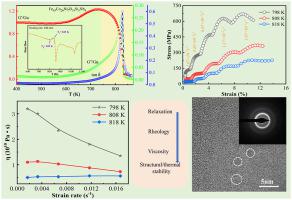当前位置:
X-MOL 学术
›
J. Alloys Compd.
›
论文详情
Our official English website, www.x-mol.net, welcomes your
feedback! (Note: you will need to create a separate account there.)
Microscopic hardness and dynamic mechanical analysis of rapidly solidified Fe-based amorphous alloys
Journal of Alloys and Compounds ( IF 5.8 ) Pub Date : 2020-11-01 , DOI: 10.1016/j.jallcom.2020.157957 P.C. Zhang , Y.J. Hu , J. Chang , H.P. Wang
Journal of Alloys and Compounds ( IF 5.8 ) Pub Date : 2020-11-01 , DOI: 10.1016/j.jallcom.2020.157957 P.C. Zhang , Y.J. Hu , J. Chang , H.P. Wang

|
Abstract A systematic work was conducted to investigate the nanoindentation, dynamic relaxation, high-temperature rheological behavior, and structural relaxation after high-temperature deformation of Fe52-xCo20NixB19Si5Nb4 (x=7,12,17, labeled as S1, S2 and S3) metallic glass. The results of nanoindentation indicate that the hardness of amorphous alloy reduces first and then enhances with the increase of Ni content. S1 alloy exhibits the highest hardness of 13∼16 GPa, while relatively excellent compression plasticity is reached in S2 alloy. Besides, the glass transition temperature (Tg), initial crystallization temperature (Tx), α relaxation temperature (Tα) and internal friction change at different temperatures were determined and compared. The critical temperature, strain rate during non-Newton to Newtonian rheology and Newtonian viscosity at Tg temperature were discussed. Moreover, it was found that the activation volume improved and then decreased due to structural relaxation. At last, combined with the width of the supercooled liquid region, relaxation behavior and rheological viscosity at high temperature, the microstructure evolution of the three kinds of metallic glass under Tg temperature deformation was explained.
中文翻译:

快速凝固铁基非晶合金的显微硬度和动态力学分析
摘要 系统地研究了 Fe52-xCo20NixB19Si5Nb4 (x=7,12,17, 标记为 S1、S2 和 S3) 高温变形后的纳米压痕、动态弛豫、高温流变行为和结构弛豫。玻璃。纳米压痕结果表明,随着Ni含量的增加,非晶合金的硬度先降低后提高。S1 合金的硬度最高,为 13~16 GPa,而 S2 合金则达到了较好的压缩塑性。此外,还测定并比较了不同温度下的玻璃化转变温度(Tg)、初始结晶温度(Tx)、α弛豫温度(Tα)和内摩擦变化。临界温度,讨论了非牛顿应变率到牛顿流变学和 Tg 温度下的牛顿粘度。此外,发现由于结构松弛,活化体积先增加然后减少。最后,结合过冷液体区的宽度、弛豫行为和高温流变粘度,解释了三种金属玻璃在Tg温度变形下的微观结构演变。
更新日期:2020-11-01
中文翻译:

快速凝固铁基非晶合金的显微硬度和动态力学分析
摘要 系统地研究了 Fe52-xCo20NixB19Si5Nb4 (x=7,12,17, 标记为 S1、S2 和 S3) 高温变形后的纳米压痕、动态弛豫、高温流变行为和结构弛豫。玻璃。纳米压痕结果表明,随着Ni含量的增加,非晶合金的硬度先降低后提高。S1 合金的硬度最高,为 13~16 GPa,而 S2 合金则达到了较好的压缩塑性。此外,还测定并比较了不同温度下的玻璃化转变温度(Tg)、初始结晶温度(Tx)、α弛豫温度(Tα)和内摩擦变化。临界温度,讨论了非牛顿应变率到牛顿流变学和 Tg 温度下的牛顿粘度。此外,发现由于结构松弛,活化体积先增加然后减少。最后,结合过冷液体区的宽度、弛豫行为和高温流变粘度,解释了三种金属玻璃在Tg温度变形下的微观结构演变。











































 京公网安备 11010802027423号
京公网安备 11010802027423号